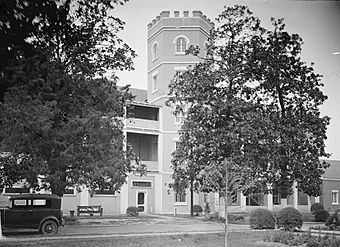Mount Vernon Arsenal facts for kids
Quick facts for kids |
|
|
Mount Vernon Arsenal-Searcy Hospital Complex
|
|

The old barracks building in 1935
|
|
| Nearest city | Mount Vernon, Alabama |
|---|---|
| Area | 36 acres (15 ha) |
| Architectural style | Classical Revival, Greek Revival |
| NRHP reference No. | 88000676 |
| Added to NRHP | May 26, 1988 |
The Mount Vernon Arsenal is a historic place in Mount Vernon, Alabama. It was once a place where the United States Army stored and made military supplies. Over the years, it also served as a prison for Native Americans and later as a hospital. Today, it's known as the Mount Vernon Arsenal-Searcy Hospital Complex and is listed on the National Register of Historic Places.
History of the Mount Vernon Arsenal
The Mount Vernon Arsenal was built by the United States Army in 1828. It was located near the Mobile River in Alabama. This spot was about 30 miles from the Gulf of Mexico.
The arsenal was one of the main places for making ammunition for the U.S. Army. It was used for this purpose until the American Civil War. It is one of the most complete arsenals from before the Civil War that still exists today.
The Civil War and Beyond
On January 4, 1861, soldiers from the Alabama state militia took control of the arsenal. A militia is a group of citizens who act as soldiers. They followed orders from Alabama's governor, Andrew B. Moore. The small U.S. Army group there, led by Captain Jesse L. Reno, gave up peacefully. No fighting happened.
After Alabama joined other states to form the Confederate States of America, the arsenal was given to the Confederate States Army. This happened for the rest of the war. In 1862, after the Battle of New Orleans, the Confederacy moved its ammunition making. They moved it from Mount Vernon to Selma, Alabama. Selma was a safer place, farther from Union forces.
The Confederate Army held the arsenal almost until the end of the Civil War. After the war, the arsenal was returned to the U.S. government. Its name was changed to the Mount Vernon Barracks.
Later Uses of the Site
From 1887 to 1894, the Barracks became a prison. It held captured Apache people, including the famous leader Geronimo and his followers.
A well-known doctor, Walter Reed, also worked there. He was an Army physician in the 1880s. He later proved that yellow fever is spread by mosquitoes.
In 1895, the site was given to the state of Alabama.



